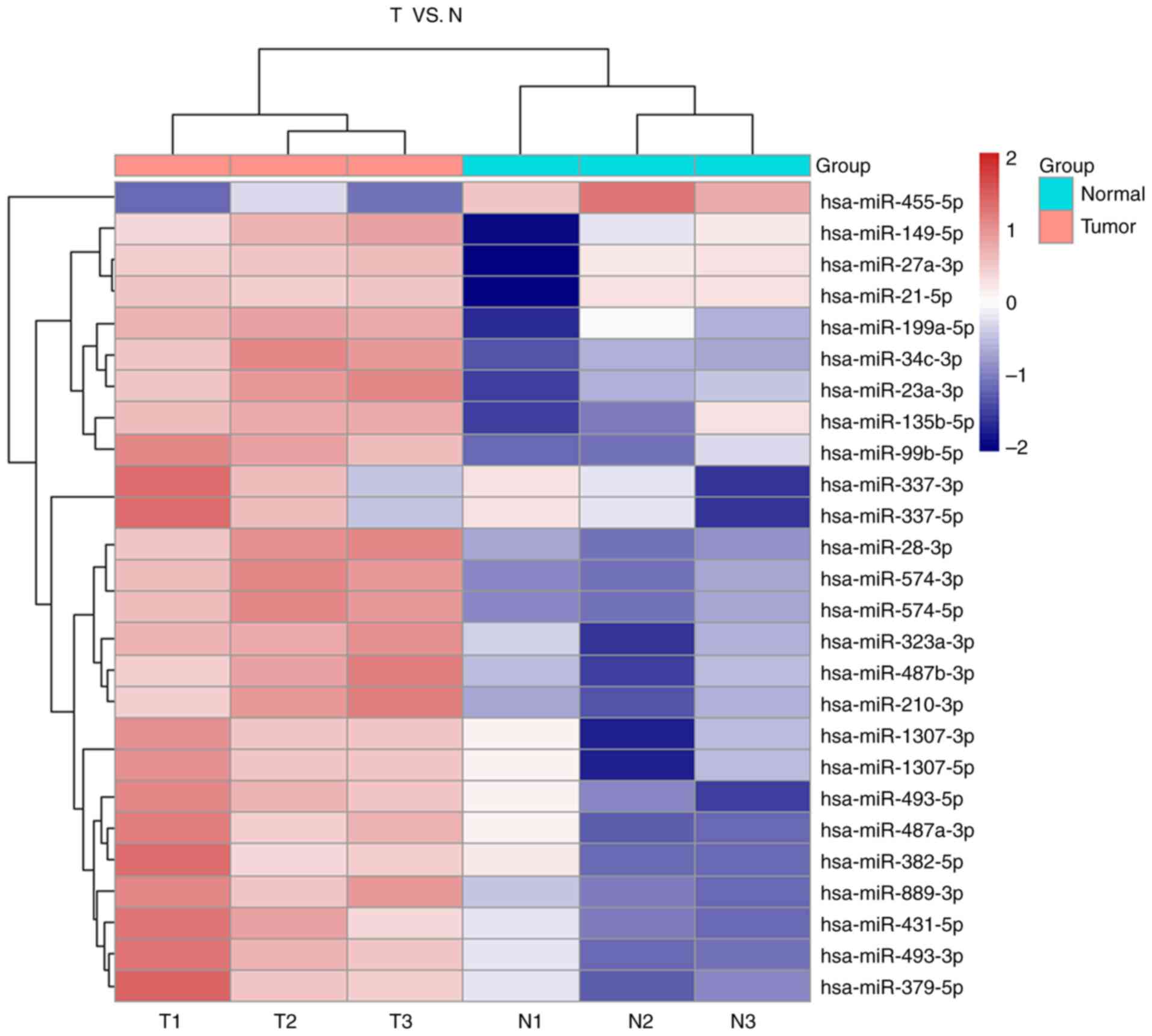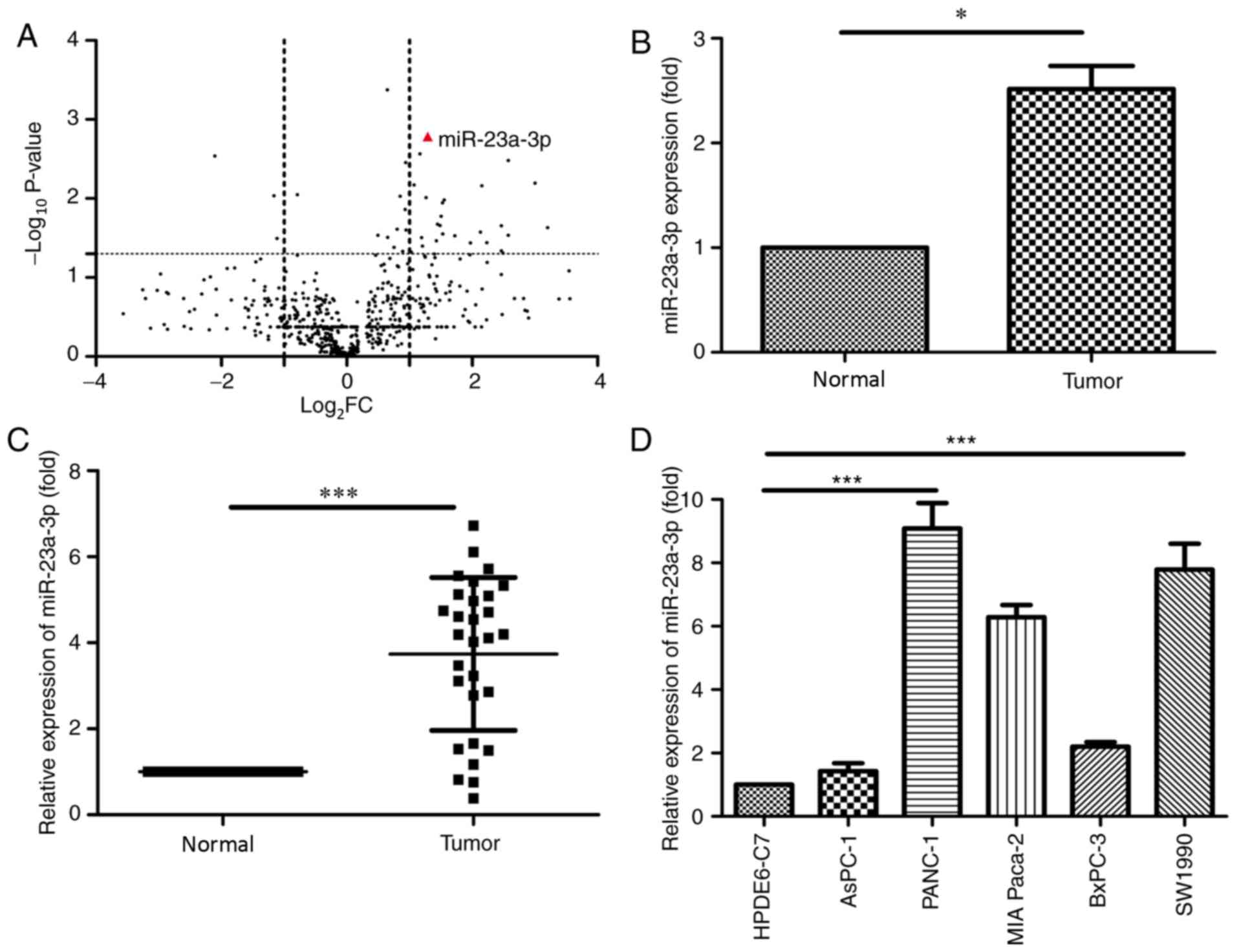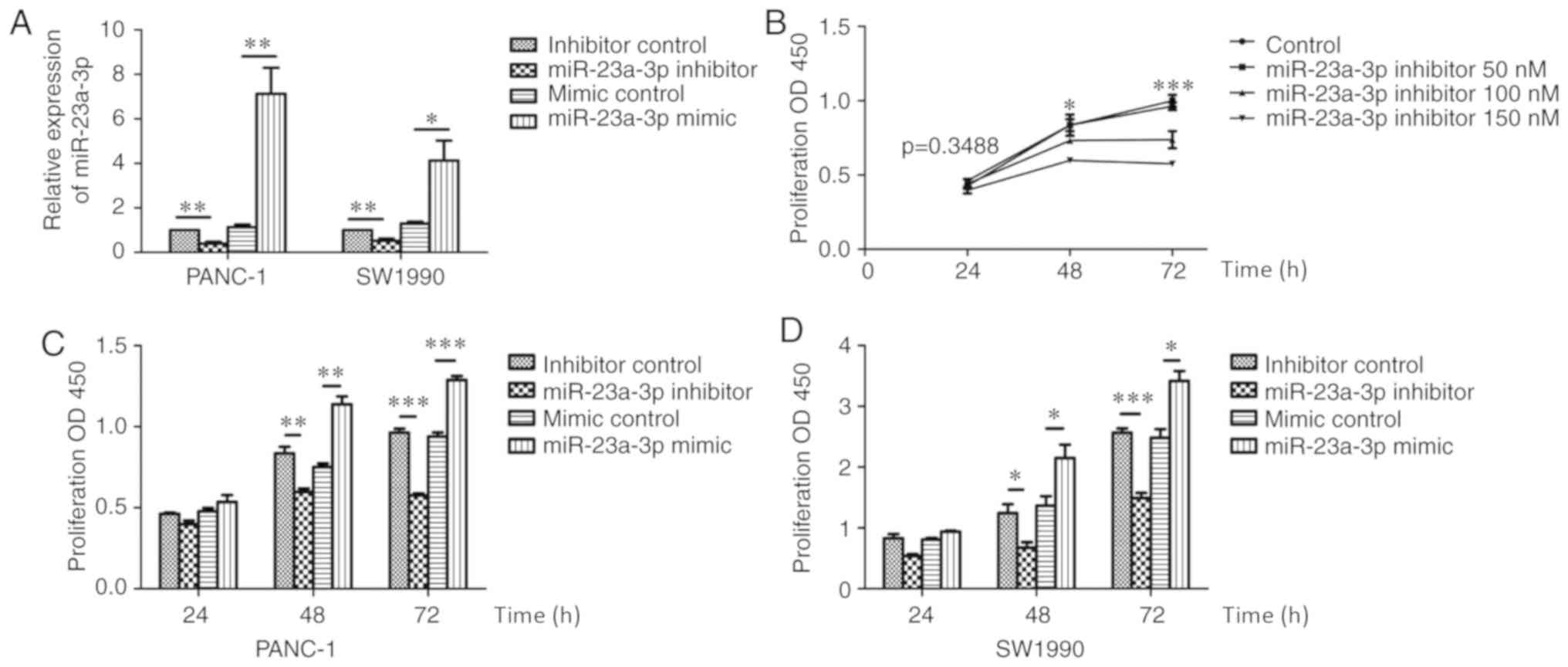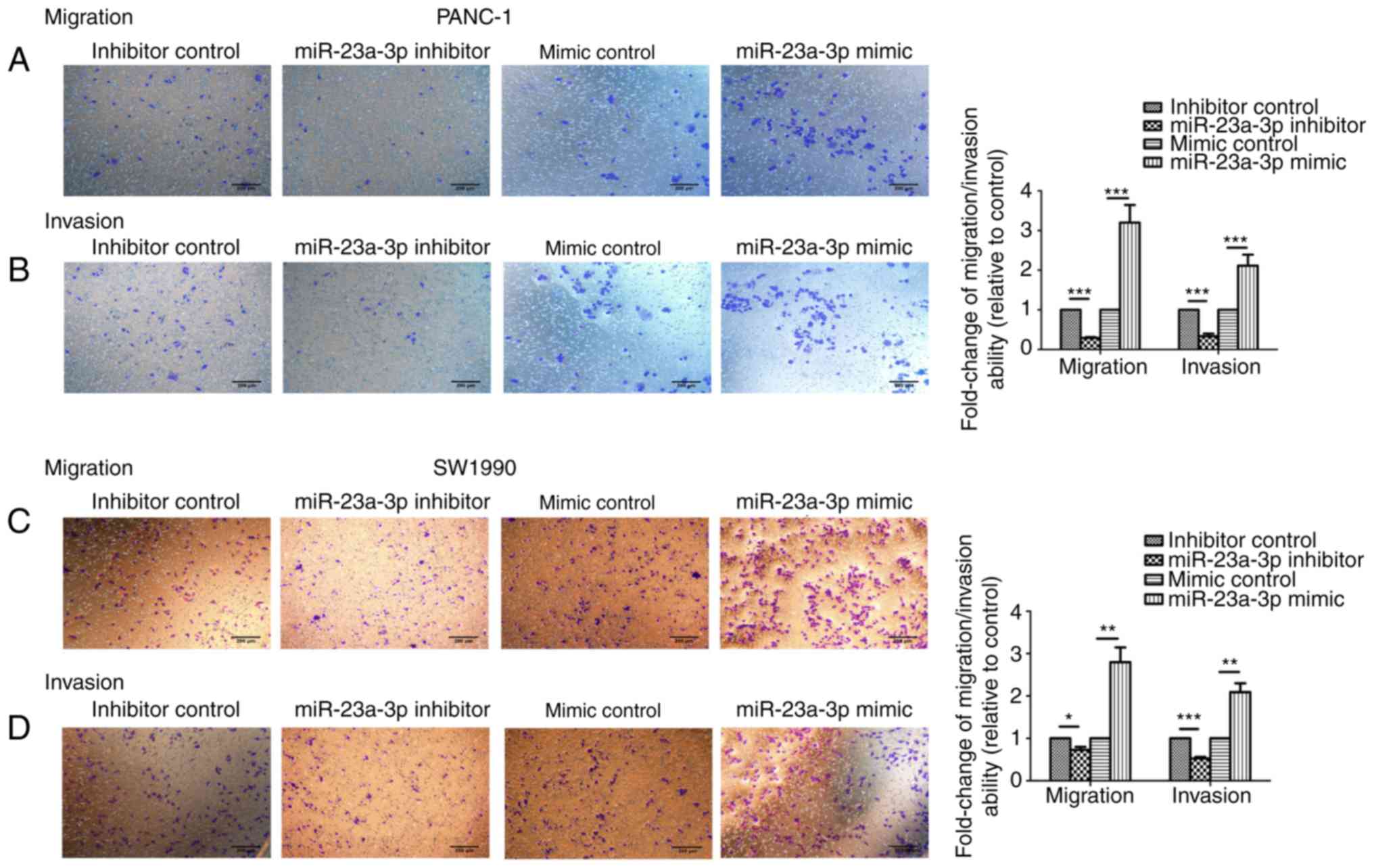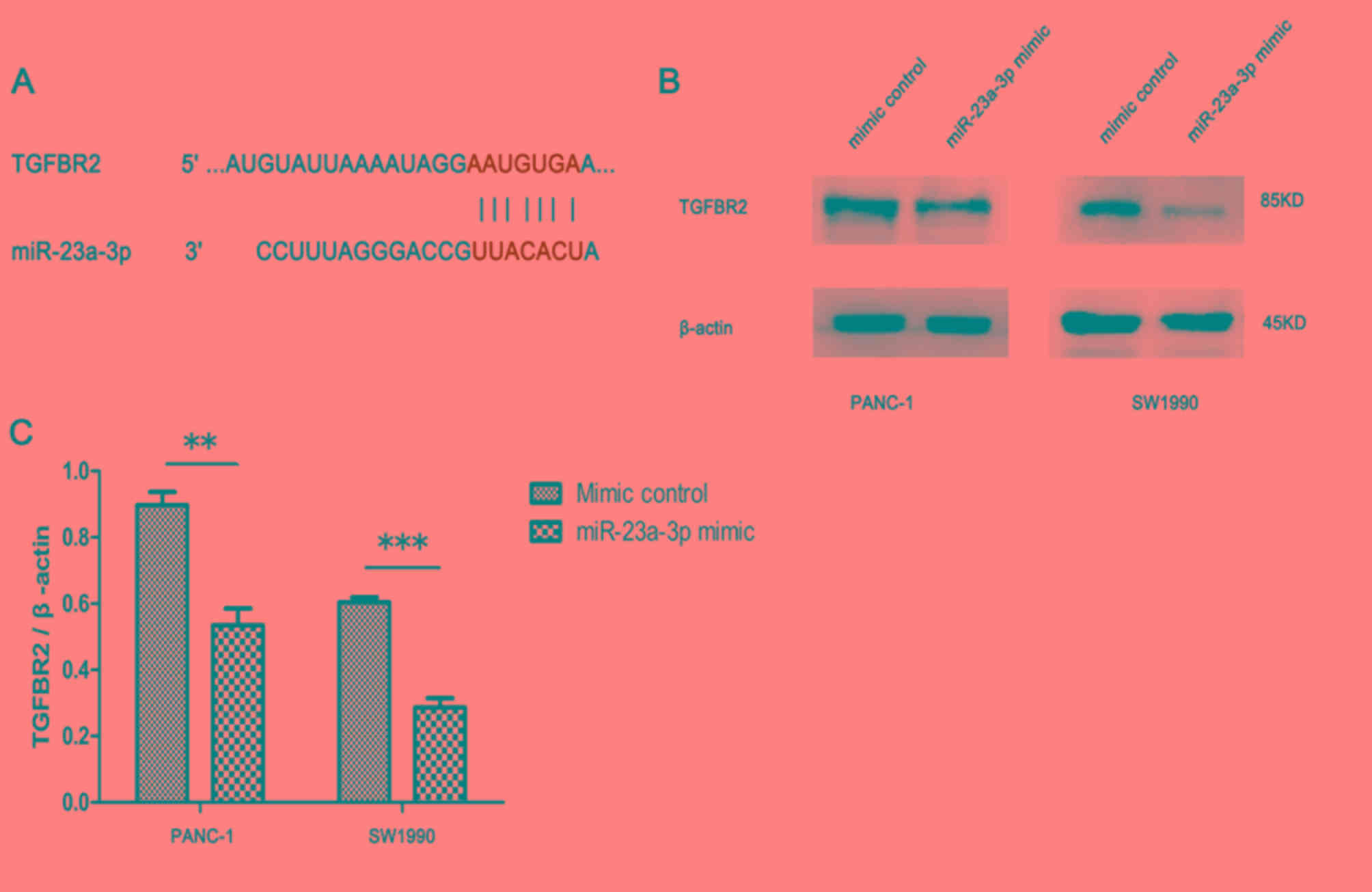|
1
|
US Preventive Services Task Force, ; Owens
DK, Davidson KW, Krist AH, Barry MJ, Cabana M, Caughey AB, Curry
SJ, Doubeni CA, Epling JW Jr, et al: Screening for pancreatic
cancer: US preventive services task force reaffirmation
recommendation statement. JAMA. 322:438–444. 2019. View Article : Google Scholar : PubMed/NCBI
|
|
2
|
McGuigan A, Kelly P, Turkington RC, Jones
C, Coleman HG and McCain RS: Pancreatic cancer: A review of
clinical diagnosis, epidemiology, treatment and outcomes. World J
Gastroenterol. 24:4846–4861. 2018. View Article : Google Scholar : PubMed/NCBI
|
|
3
|
Zhang Y, Yang P and Wang XF:
Microenvironmental regulation of cancer metastasis by miRNAs.
Trends Cell Biol. 24:153–160. 2014. View Article : Google Scholar : PubMed/NCBI
|
|
4
|
Tassinari V, Cesarini V, Silvestris DA and
Gallo A: The adaptive potential of RNA editing-mediated
miRNA-retargeting in cancer. Biochim Biophys Acta Gene Regul Mech.
1862:291–300. 2019. View Article : Google Scholar : PubMed/NCBI
|
|
5
|
Kwok GT, Zhao JT, Weiss J, Mugridge N,
Brahmbhatt H, MacDiarmid JA, Robinson BG and Sidhu SB:
Translational applications of microRNAs in cancer, and therapeutic
implications. Noncoding RNA Res. 2:143–150. 2017. View Article : Google Scholar : PubMed/NCBI
|
|
6
|
Frampton AE, Castellano L, Colombo T,
Giovannetti E, Krell J, Jacob J, Pellegrino L, Roca-Alonso L, Funel
N, Gall TM, et al: MicroRNAs cooperatively inhibit a network of
tumor suppressor genes to promote pancreatic tumor growth and
progression. Gastroenterology. 146:268–277.e18. 2014. View Article : Google Scholar : PubMed/NCBI
|
|
7
|
Zhang L, Gao LG, Zhang M and Zhou XL:
Genotype-phenotype analysis of F-helix mutations at the kinase
domain of TGFBR2, including a type 2 Marfan syndrome familial
study. Mol Vis. 18:55–63. 2012.PubMed/NCBI
|
|
8
|
Luo J, Chen XQ and Li P: The Role of TGF-β
and its receptors in gastrointestinal cancers. Transl Oncol.
12:475–484. 2019. View Article : Google Scholar : PubMed/NCBI
|
|
9
|
Pu XH, Li F, Miao XL, Ye JL and Lu LG:
Transforming growth factor beta regulates hepatic progenitor cells
migration via PI3K/AKT/mTOR/p70S6K pathway. Zhonghua Gan Zang Bing
Za Zhi. 26:680–685. 2018.(In Chinese). PubMed/NCBI
|
|
10
|
Zhou H, Wu G, Ma X, Xiao J, Yu G, Yang C,
Xu N, Zhang B, Zhou J, Ye Z and Wang Z: Attenuation of TGFBR2
expression and tumour progression in prostate cancer involve
diverse hypoxia-regulated pathways. J Exp Clin Cancer Res.
37:892018. View Article : Google Scholar : PubMed/NCBI
|
|
11
|
Edge SB and Compton CC: The American Joint
Committee on Cancer: The 7th edition of the AJCC Cancer Staging
Manual and the Future of TNM. Ann Surg Oncol. 17:1471–1474. 2010.
View Article : Google Scholar : PubMed/NCBI
|
|
12
|
Greene FL and Sobin LH: A worldwide
approach to the TNM staging system: Collaborative efforts of the
AJCC and UICC. J Surg Oncol. 99:269–272. 2009. View Article : Google Scholar : PubMed/NCBI
|
|
13
|
Livak KG and Schmittgen TD: Analysis of
relative gene expression data using real-time quantitative PCR and
the 2(-Delta Delta C (T)) method. Methods. 25:402–408. 2001.
View Article : Google Scholar : PubMed/NCBI
|
|
14
|
Olive V, Bennett MJ, Walker JC, Ma C,
Jiang I, Cordon-Cardo C, Li QJ, Lowe SW, Hannon GJ and He L: miR-19
is a key oncogenic component of mir-17-92. Genes Dev. 23:2839–2849.
2009. View Article : Google Scholar : PubMed/NCBI
|
|
15
|
Yang D, Liu G and Wang K: miR-203 Acts as
a tumor suppressor gene in osteosarcoma by regulating RAB22A. PLoS
One. 10:e01322252015. View Article : Google Scholar : PubMed/NCBI
|
|
16
|
Zhou J, Lu S, Yang S, Chen H, Shi H, Miao
M and Jiao B: MicroRNA-127 post-transcriptionally downregulates
Sept7 and suppresses cell growth in hepatocellular carcinoma cells.
Cell Physiol Biochem. 33:1537–1546. 2014. View Article : Google Scholar : PubMed/NCBI
|
|
17
|
Chen F, Qi S, Zhang X, Wu J, Yang X and
Wang R: miR-23a-3p suppresses cell proliferation in oral squamous
cell carcinomas by targeting FGF2 and correlates with a better
prognosis: miR-23a-3p inhibits OSCC growth by targeting FGF2.
Pathol Res Pract. 215:660–667. 2019. View Article : Google Scholar : PubMed/NCBI
|
|
18
|
Ding F, Lai J, Gao Y, Wang G, Shang J,
Zhang D and Zheng S: NEAT1/miR-23a-3p/KLF3: A novel regulatory axis
in melanoma cancer progression. Cancer Cell Int. 19:2172019.
View Article : Google Scholar : PubMed/NCBI
|
|
19
|
Liu J, Fan L, Yu H, Zhang J, He Y, Feng D,
Wang F, Li X, Liu Q, Li Y, et al: Endoplasmic reticulum stress
causes liver cancer cells to release exosomal miR-23a-3p and
Up-regulate programmed death ligand 1 expression in macrophages.
Hepatology. 70:241–258. 2019.PubMed/NCBI
|
|
20
|
Quan J, Pan X, Li Y, Hu Y, Tao L, Li Z,
Zhao L, Wang J, Li H, Lai Y, et al: MiR-23a-3p acts as an oncogene
and potential prognostic biomarker by targeting PNRC2 in RCC.
Biomed Pharmacother. 110:656–666. 2019. View Article : Google Scholar : PubMed/NCBI
|
|
21
|
Karmakar S, Kaushik G, Nimmakayala R,
Rachagani S, Ponnusamy MP and Batra SK: MicroRNA regulation of
K-Ras in pancreatic cancer and opportunities for therapeutic
intervention. Semin Cancer Biol. 54:63–71. 2019. View Article : Google Scholar : PubMed/NCBI
|
|
22
|
Vychytilova-Faltejskova P, Radova L,
Sachlova M, Kosarova Z, Slaba K, Fabian P, Grolich T, Prochazka V,
Kala Z, Svoboda M, et al: Serum-based microRNA signatures in early
diagnosis and prognosis prediction of colon cancer. Carcinogenesis.
37:941–950. 2016. View Article : Google Scholar : PubMed/NCBI
|
|
23
|
Ostenfeld MS, Jensen SG, Jeppesen DK,
Christensen LL, Thorsen SB, Stenvang J, Hvam ML, Thomsen A,
Mouritzen P, Rasmussen MH, et al: miRNA profiling of circulating
EpCAM(+) extracellular vesicles: Promising biomarkers of colorectal
cancer. J Extracell Vesicles. 5:314882016. View Article : Google Scholar : PubMed/NCBI
|
|
24
|
Jahid S, Sun J, Edwards RA, Dizon D,
Panarelli NC, Milsom JW, Sikandar SS, Gumus ZH and Lipkin SM:
miR-23a promotes the transition from indolent to invasive
colorectal cancer. Cancer Discov. 2:540–553. 2012. View Article : Google Scholar : PubMed/NCBI
|
|
25
|
Zhu L, Jin L, Jiang R, Wang Q, Jiang J,
Mao C and Chen D: Correlations between miRNAs and TGF-β1 in tumor
microenvironment of esophageal squamous cell cancer. Xi Bao Yu Fen
Zi Mian Yi Xue Za Zhi. 29:524–528. 2013.(In Chinese). PubMed/NCBI
|
|
26
|
Ito S, Kamoto Y, Sakai A, Sasai K, Hayashi
T, Toyooka S and Katayama H: Unique circulating microRNAs in
relation to EGFR mutation status in Japanese smoker male with lung
adenocarcinoma. Oncotarget. 8:114685–114697. 2017. View Article : Google Scholar : PubMed/NCBI
|
|
27
|
Honegger A, Schilling D, Bastian S,
Sponagel J, Kuryshev V, Sultmann H, Scheffner M, Hoppe-Seyler K and
Hoppe-Seyler F: Dependence of intracellular and exosomal microRNAs
on viral E6/E7 oncogene expression in HPV-positive tumor cells.
PLoS Pathog. 11:e10047122015. View Article : Google Scholar : PubMed/NCBI
|
|
28
|
Calatayud D, Dehlendorff C, Boisen MK,
Hasselby JP, Schultz NA, Werner J, Immervoll H, Molven A, Hansen CP
and Johansen JS: Tissue MicroRNA profiles as diagnostic and
prognostic biomarkers in patients with resectable pancreatic ductal
adenocarcinoma and periampullary cancers. Biomark Res. 5:82017.
View Article : Google Scholar : PubMed/NCBI
|
|
29
|
Drabsch Y and ten Dijke P: TGF-β
signalling and its role in cancer progression and metastasis.
Cancer Metastasis Rev. 31:553–568. 2012. View Article : Google Scholar : PubMed/NCBI
|
|
30
|
He H, Zhao X, Zhu Z, Du L, Chen E, Liu S,
Li Q, Dong J, Yang J and Lei L: MicroRNA-3191 promotes migration
and invasion by downregulating TGFBR2 in colorectal cancer. J
Biochem Mol Toxicol. e22308:2019.
|
|
31
|
Tarfiei GA, Shadboorestan A, Montazeri H,
Rahmanian N, Tavosi G and Ghahremani MH: GDF15 induced apoptosis
and cytotoxicity in A549 cells depends on TGFBR2 expression. Cell
Biochem Funct. 37:320–330. 2019. View
Article : Google Scholar : PubMed/NCBI
|
|
32
|
Wang Y, Tan X, Tang Y, Zhang C, Xu J, Zhou
J, Cheng X, Hou N, Liu W, Yang G, et al: Dysregulated
Tgfbr2/ERK-Smad4/SOX2 signaling promotes lung squamous cell
carcinoma formation. Cancer Res. 79:4466–4479. 2019.PubMed/NCBI
|
|
33
|
Shima K, Morikawa T, Yamauchi M, Kuchiba
A, Imamura Y, Liao X, Meyerhardt JA, Fuchs CS and Ogino S: TGFBR2
and BAX mononucleotide tract mutations, microsatellite instability,
and prognosis in 1072 colorectal cancers. PLoS One. 6:e250622011.
View Article : Google Scholar : PubMed/NCBI
|
|
34
|
Zhou B, Guo W, Sun C, Zhang B and Zheng F:
Linc00462 promotes pancreatic cancer invasiveness through the
miR-665/TGFBR1-TGFBR2/SMAD2/3 pathway. Cell Death Dis. 9:7062018.
View Article : Google Scholar : PubMed/NCBI
|
|
35
|
Yang H, Zhang H, Zhong Y, Wang Q, Yang L,
Kang H, Gao X, Yu H, Xie C, Zhou F and Zhou Y: Concomitant
underexpression of TGFBR2 and overexpression of hTERT are
associated with poor prognosis in cervical cancer. Sci Rep.
7:416702017. View Article : Google Scholar : PubMed/NCBI
|















